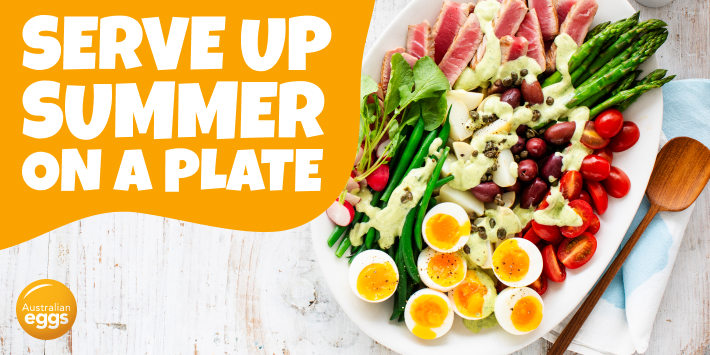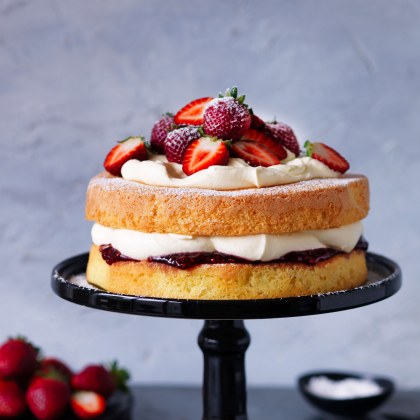11 easy tips for a fluffy sponge cake
There’s nothing quite like a slice of moist and fluffy sponge cake. With a light melt-in-your-mouth texture and delicate flavour, it’s a classic cake and real people pleaser, wonderful for celebrations, entertaining or a special afternoon tea.
A few tips and tricks make it easier to get that beautifully airy and tender texture. With the recipe and steps below, your sponges will be a success every time.
Watch how to make a sponge cake
INGREDIENTS
- 4 eggs, at room temperature
- ⅔ cup (150g) caster sugar
- 2 tsp vanilla extract
- ⅔ cup (100g) self-raising flour
- ⅓ cup (50g) plain flour
METHOD
- Preheat oven to 180°C/160°C (fan-forced). Grease 22cm diameter round cake pan. Line base and sides with baking paper, extending paper 3cm above pan edges.
- Place eggs in a large bowl of an electric mixer. Using the whisk attachment, beat for 7-8 minutes on high speed or until very thick and pale. Add sugar, 1 tbsp at a time, beating between each addition. Beat in vanilla.
- Sift flours twice onto a sheet of baking paper then sift again over egg mixture. Add 1 tbsp boiling water. Gently fold to combine. Do not stir. Divide evenly amongst prepared pans.
- Bake for 35 minutes, or until golden brown and sponge slightly shrinks away from pan sides. Immediately turn out onto a wire rack lined with greased baking to paper. Allow to cool.
Get the recipes that you can save to your myfoodbook cookbooks here:
These recipes all use the same base sponge recipe.
Fluffy sponge cake tips
How to prepare a cake pan
It’s important to prepare the pans as follows so the cake will rise properly and come out of the pan with ease.
- Trace the base of the cake pan onto baking paper and cut to fit. Measure a piece of baking paper to line the sides.
- Grease cake pans with butter or cooking spray.
- Place paper inside cake pan.
- Grease again, then lightly dust with plain flour.
Be prepared
Sponge cakes have a delicate batter that works best when it’s baked as soon as possible. To reduce the amount of time between making the batter and getting it in the oven, weigh and measure all the ingredients before you start, ensure your cake pan is ready to go, and have the oven preheating.
How long should you beat eggs for sponge cake?
Whipping the eggs is a very important part of the process, so don’t skimp on the time! You need to incorporate as much air into the eggs as possible, as this is what levels the cake and will give you a light and fluffy sponge.
Set a timer for 7 minutes and allow the electric mixer to do the work before adding any sugar. The eggs should triple in volume and look pale, thick and shiny.
Do you really need to sift the flour mixture three times?
Yes! The sifting process makes the flour airy and light. This both incorporates extra air into the batter and reduces the amount of air it pushes out of the egg mixture.
What is the difference between folding and stirring?
Folding is a much gentler method of combining ingredients together. Stirring from side to side pushes air out of the batter and you'll end up with a dense cake. 'Fold' the ingredients by using an up and down scooping motion with a spatula. Scoop from the top to the bottom of the bowl, giving the bowl quarter turns until the flour is just incorporated. Fold the flour into the eggs in two batches to reduce the amount of air loss.
How to get even cakes
The best way to get even cakes is to use a scale to calculate the weight of the batter that should go into each pan.
To do this, weigh the empty bowl before you begin. Once the batter has been made, weigh the batter and bowl together. Subtract the weight of the empty bowl to give you the weight of the cake batter. Divide this by the number of pans. Voila! That’s the weight of batter you need in each pan for nice and even cakes.
Don’t wait to bake!
Once your batter is prepared, bake it in the oven as soon as possible. Any standing time will impact on the rise of the cake, so it's important that your oven has been preheating while you're making the batter.
How to tell when your cake is cooked
Bake for 20 minutes or recipe recommendations. To check if the cake is done, insert a skewer into the centre. If it comes out clean, the cake is cooked. A cooked cake will also shrink and begin pulling away from the sides of the tin. Another indicator is that your kitchen will fill with the smell of freshly baked cake.
How to cool a sponge cake
Immediately turn out the cakes to cool. Remove the baking paper, and it place onto a wire rack lined with a new sheet of greased baking paper to stop it from sticking.
If making the cakes ahead of time, wrap cakes individually in cling film while they are still slightly warm. This will soften the crusts so they’re easier to trim. Store at room temperature.
How to frost a cake
This sponge is lovely simply topped whipped cream and jam or your favourite fruits. Or to frost it:
- Chill the cake for 30-60 minutes to firm it up.
- Divide the frosting into two bowls, cover one and set aside.
- Coat the cake thinly with the first half of the frosting to create a ‘crumb coat’. This captures loose crumbs on the surface.
- Refrigerate or freeze cake for one hour to harden.
- Use the remaining frosting to do a smooth final coat.
If you're finding it difficult to get a smooth finish, try using an offset spatula and wiping off the icing each time you smooth the cake.
How to serve a sponge cake
You’ve worked so hard to get a beautifully fluffy sponge, make sure to serve it at room temperature for the best texture! The texture will be denser if served cold.
Take the cake from refrigerator at least an hour before serving and use a long knife to slice, ensuring it’s nice and sharp so it doesn’t crush the airy cake.
More baking projects
Want more great baking projects? Click to check out how to make focaccia from scratch, how to make Dutch baby pancakes and how to make the best-baked cheesecake!
GET THE RECIPE: Traditional Sponge Cake with Jam and Cream by Australian Eggs
GET THE RECIPE: Sponge Cake with Cream and Passionfruit Curd by Australian Eggs














